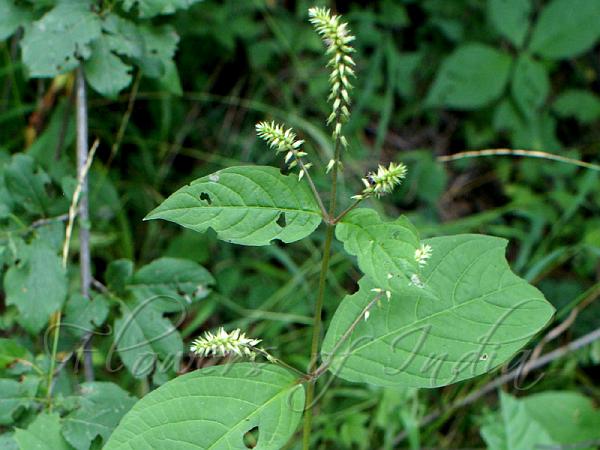|
| Ox Knee |
|

|

| File size | 137735 |
| Original date | 7/30/11 12:07 PM |
| Resolution | 800 x 600 |
| Flash | Flash did not fire, auto |
| Focal length | 22.0mm |
| Exposure time | 1/40s |
| Aperture | 4.5 |
| Focus Distance | |
| Metering Mode | Multi-segment |
| Camera make | SONY |
| Camera model | DSLR-A100 |
| Sensor type |
|
|
|
|
Photo: |
Botanical name: Achyranthes bidentata Family: Amaranthaceae (Amaranth family)
Synonyms: Achyranthes hispida, Achyranthes japonica, Achyranthes chinensis
Synonyms: Achyranthes hispida, Achyranthes japonica, Achyranthes chinensis
Ox Knee is an erect or straggling herb, 0.6-2 m,
much-branched. Stem and branches are indistinctly quadrangular or
channeled, hairless to moderately (rarely more densely) hairy, the
nodes frequently much shrunken when dry. Leaves are elliptic-oblong to
broadly oval, rarely narrowly lanceshaped, shortly or longly
long-pointed, gradually or more abruptly narrowed below, 9-22 x 2.5-8.5
cm, usually thinly hairy, rarely densely appressed-hairy on the lower
surface. Stalks of main stem leaves are 0.3-2 cm long, shortening above
and below. Inflorescences at first dense, finally lax and elongating to
as much as 20 cm but commonly about half this length, the inflorescence
stalk is 1-4 cm. Bracts are narrowly lanceshaped, brownish-membranous,
3-5 mm, hairless. Bracteoles are 3.5-5.5 mm. Tepals are 5, 4-7 mm, the
outer longest, all narrowly lanceshaped, very acute, with a distinct
midrib and 2 obscure or obvious lateral nerves, narrowly pale-margined.
Capsule is 2-3 mm. Seed filling the capsule, cylindrical smooth. This
species is globally distributed in the Paleotropics. Within India, it
is found throughout the hilly regions between an altitude range of
1200-3200 m, and is common in waste places and in shady oak-forests.
Medicinal uses: In Nepal its root juice is
used for toothache. Its seeds have been used as a substitute for cereal
grains in famine years. The plant is used externally in the treatment
of leech bites in Mizoram, India and a decoction as a diuretic.
In Nepal its root juice is
used for toothache. Its seeds have been used as a substitute for cereal
grains in famine years. The plant is used externally in the treatment
of leech bites in Mizoram, India and a decoction as a diuretic.
Medicinal uses:
 In Nepal its root juice is
used for toothache. Its seeds have been used as a substitute for cereal
grains in famine years. The plant is used externally in the treatment
of leech bites in Mizoram, India and a decoction as a diuretic.
In Nepal its root juice is
used for toothache. Its seeds have been used as a substitute for cereal
grains in famine years. The plant is used externally in the treatment
of leech bites in Mizoram, India and a decoction as a diuretic. | Identification credit: Gurcharan Singh | Photographed in Dachhigam forest, Kashmir. |
• Is this flower misidentified? If yes,